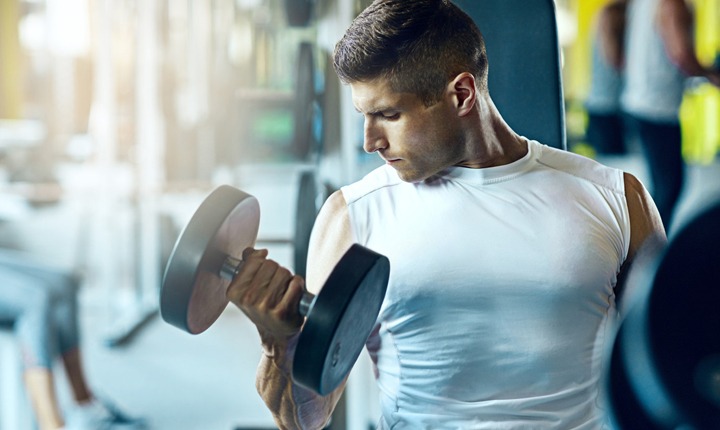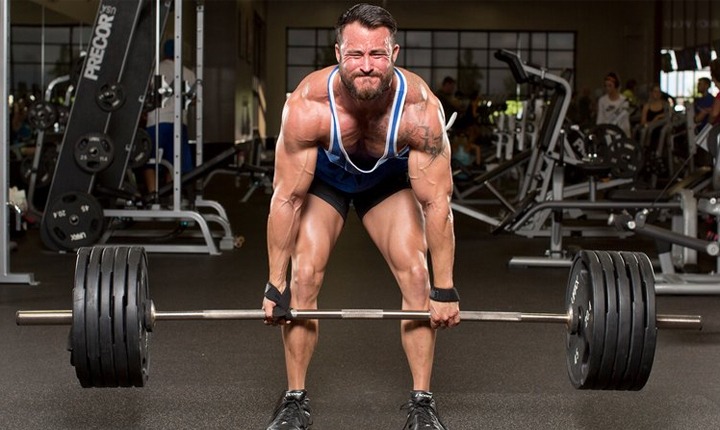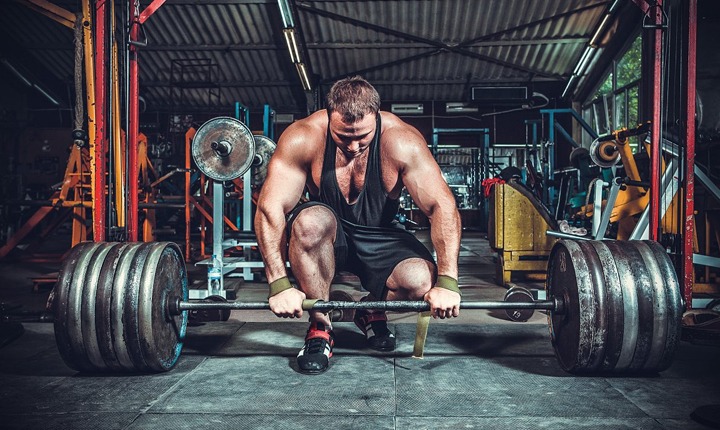Many people have a concept that hitting the gyms for long hours and running for elongated time may help them build perfect muscles and strengthen their body. Do you think in the same way?
Let us tell you, that’s partially correct because if you want a full-body workout for gaining strength, reducing weight and building solid muscles by cutting fat then practicing a set of full body dumbbell workouts are necessary to accomplish your fitness targets. Just keep yourself dedicated towards your fitness goals, diet regime and daily routine without skipping any step.
According to BMJ Global Health, the dumbbell exercise is a therapy which not only maintains your weight and muscles but also reduces life-threatening breast cancer. You don’t need much equipment to practice the best dumbbell workouts, just a pair of dumbbells it enough as per the weight recommendation of health experts.
How to Do Full Body Dumbbell Workout?
You may practice crunches, pullups, jogging, and squats, but dumbbell workouts will help you fulfill all the fitness targets you want to accomplish. However, you need a proficient fitness trainer of the best gym in Kolkata who can teach you the exact ways to lift up dumbbells and do full-body exercises.
Remember, practicing wrong dumbbell workouts may lead to injury or stretch marks in your arms and other parts of your body. So, health Experts suggest practicing some best dumbbell workouts for all-level gym-goers so that you don’t feel any confusion in practicing those steps.
Full Body Dumbbell Workouts for Beginners
Usually, novice fitness enthusiasts hold dumbbells in an unstable way because they have less experience in holding dumbbells and practicing workouts like a pro. So, their muscles need to work hard for getting stabilized. So, don’t start from intense workouts if you are just beginning a fitness regime. Have a look at some dumbbell workouts for beginners:
1. Lateral Raise
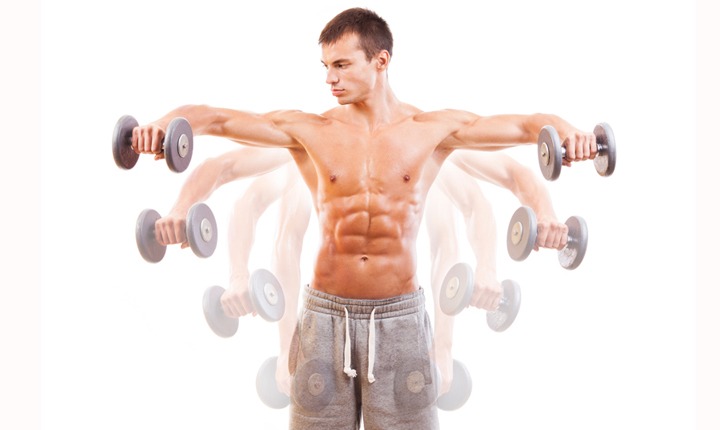
Lateral Raise targets the outer head-point of the deltoid muscles that are located on the uppermost part of the arm on the shoulders. Moreover, this dumbbell exercise will work on your entire hands and shoulders by toning up the extra flab. It brings flexibility by breaking the arduousness in your body and also works as a warm-up exercise for novice fitness lovers. Along with the hand, it is an upper-body dumbbell workout because it shapes up your arms and broadens your shoulders.
Steps:
- Choose dumbbell weight as per the direction of your fitness expert.
- Stand straight by keeping shoulder-width distance apart.
- Grab the dumbbells with your palms.
- Start raising each arm out to both the sides with the shoulder level.
- Keep the chest up by bending your elbows slightly.
- Hold the dumbbells for 2-3 seconds.
- Repeat it 5-10 times when you are a beginner.
- Now, pause the lower weights back and relax.
- Breathe normally while doing the exercise.
2. Lunge
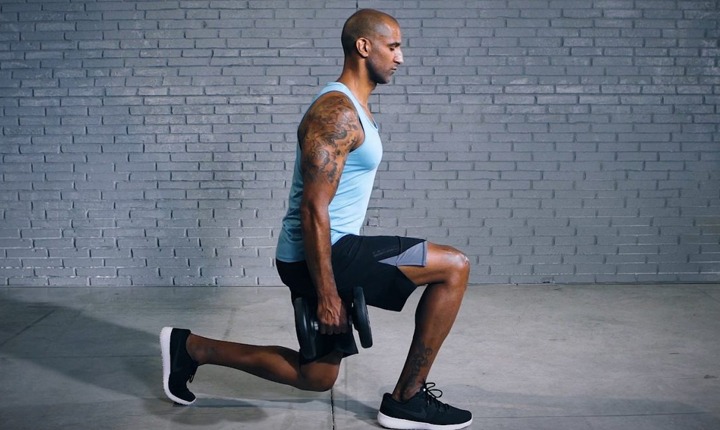
Do you want to build strength on the muscles of your legs? If yes, then definitely Lunges are great steps to tone down your legs and build solid muscles. Moreover, it will provide strength to your bones and help you win any kind of race.
Steps:
- Hold two dumbbells in your hands by both the sides.
- Stand with your torso straight.
- Now step forward with one leg around two feet and lower your upper part of the body down.
- Maintain the balance of the body while keeping the torso upwards.
- Don’t let your knees go beyond your toes because it will put stress on the knee joint.
- Push up and go back to the beginning position with the help of the heel of your foot.
- Inhale and exhale normally.
- Repeat the steps as per the direction of your fitness trainer.
3. Dumbbell Bench Press
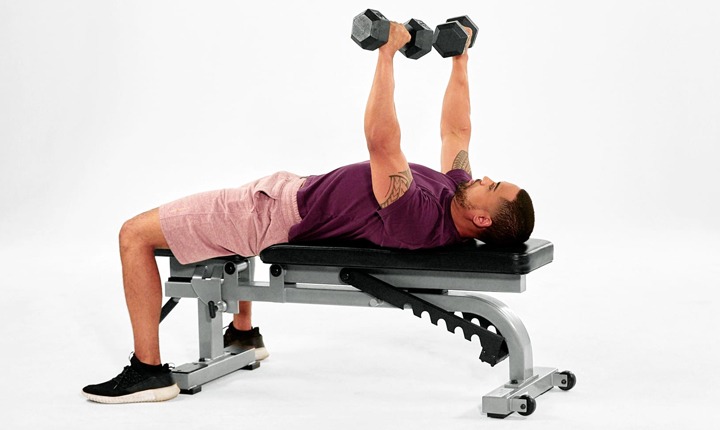
If you want to get a good shape of your chest and arms then Dumbbell Bench Press is one of the effect workouts. While practicing dumbbell bench press, always ask from proficient fitness coach about them that how much weight is needed to be lifted as per your height and weight.
Generally, this exercise is done to shape up the muscles of the arms and chest with solid muscles. Moreover, it also provides strength to the muscles of the entire body.
Steps:
- At first, lie on a bench and grab a dumbbell in each hand.
- Keep your feet flat on the floor.
- Now start pushing the dumbbells up and keep the arms over your shoulders.
- Tilt your chin towards the chest portion.
- Touch your tummy in while doing this workout.
- Keep the dumbbells down and side your elbows slightly below your shoulders.
- Now, roll up your shoulder blades up and down for 5-7 times.
- Push up the weight and don’t lock your elbows.
- Make a natural arch from your back and the bench.
- Lift as much weight as possible, otherwise, you may feel tired.
- After one set, you can repeat this dumbbell workout again.
Full Body Dumbbell Workouts for Intermediates
After the beginner stage, let’s learn about the best dumbbell workouts for intermediate fitness enthusiasts who have a basic knowledge about dumbbell exercises. Have a look at a few of them:
1. Chest Flye
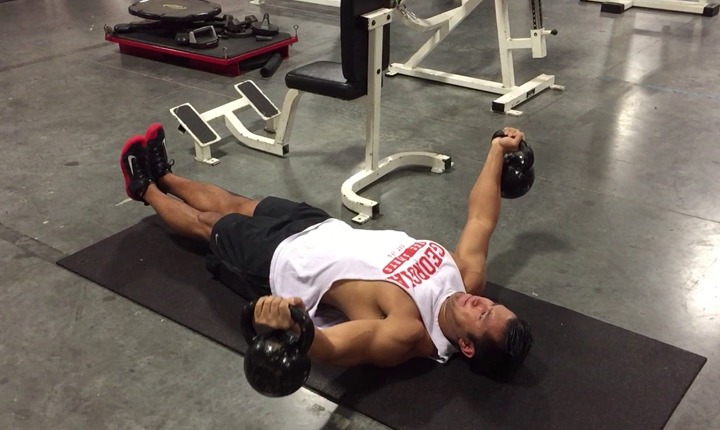
Not only on chest, but this workout also works on the shoulders, biceps, and triceps to create a perfect shape. It also strengthens up the upper-most portion of your body. So, it is one of the best strength training programs. This exercise is good for releasing stress, spondylosis and back pain. However, practice it after taking proper guidance from health experts.
Steps:
- Lie on your back straight.
- Bent your knees and feet on the floor and hold dumbbells straight just over your chest.
- Open your arms wide to both the side with a slight bend in the elbows.
- When you bring out the weight, just squeeze your chest.
- Repeat the steps 5-10 times as per your capacity and relax.
2. Front Squat
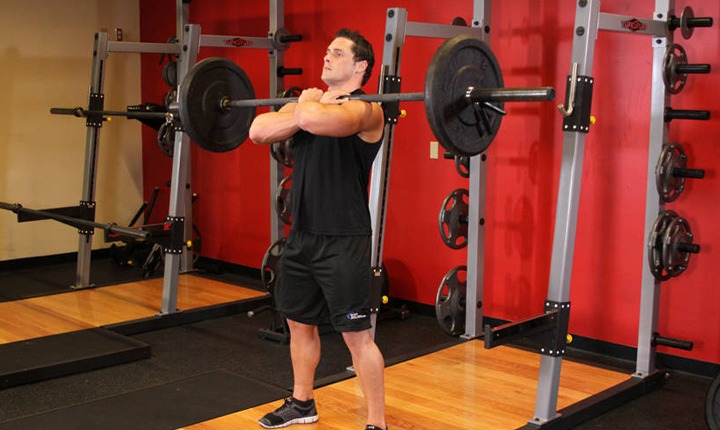
According to ‘Strength and Conditioning Journal’, Front Squat plays a great role in athletic development by strengthening the muscles and joints of athletes or sportsperson.
Front Squat is a full body dumbbell workout that works on your shoulders, elbows, hands, chest, tummy, legs and knees. This exercise also cuts down the extra fat from each portion of your body, reduce body pain, helps in forming a good posture, brings balance in your body and strengthen the muscles of your body.
Steps:
- Firstly, load bars with weight.
- Stand straight inside the squat rack after setting the bar.
- Now position yourself just under the bar.
- Rest the bar on the top of the shoulders but lift that much weight which is possible.
- Stabilize the bar by using your hands.
- Take one step backward and place your feet on both sides.
- Now, sit down between the knees and lookup.
- Sit as low as you can and make sure that your elbows are pointing upwards.
Note: This is an intense exercise, so take the help of fitness experts while practicing this.
3. Bent-Over Row
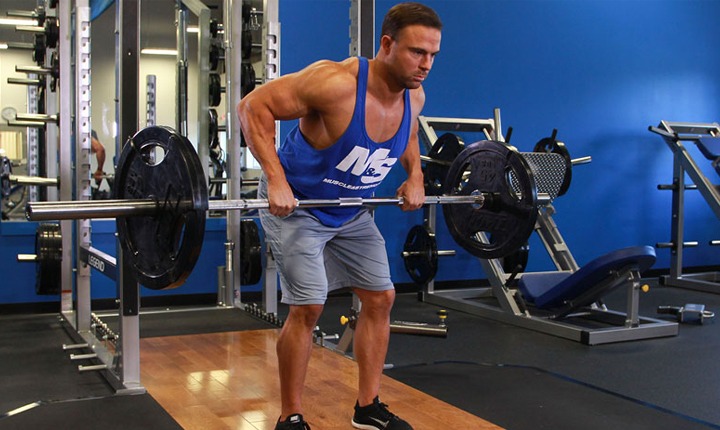
This dumbbell workout will work on your waist, tummy, legs, neckline, shoulders, and spine. It brings balance in your body and also brings flexibility.
Steps:
- Grab dumbbells or barbells on your palm with a shoulder-width grip.
- Bent your waist down towards your knees.
- Hang down the arms
- Pull the bar to the chest and lower your back down.
- Again, pull up the dumbbells or barbells.
- Do this set for 5-8 times by inhaling and exhaling well.
Full Body Dumbbell Workouts for Advanced Fitness Lovers
After becoming a dedicated fitness enthusiast, you can easily step up with any kind of dumbbell workout. Even fitness pros also practice these kinds of workouts to build their body.
1. Renegade Row
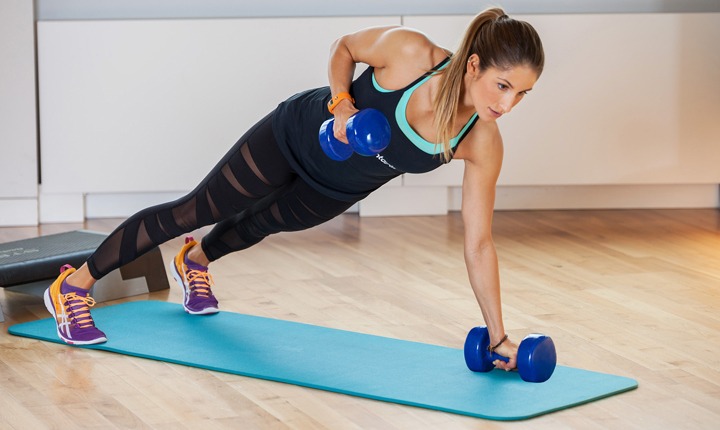
If you want to strengthen the bottom part of your body then Renegade row is one of the best dumbbell workouts. Moreover, it helps you in shaping up the upper portion of your body and arms.
Steps:
- Position the dumbbells or kettlebells on the floor and keep shoulder-width apart.
- Keep your body straight and extended.
- Support your upper body by handling the handles of the kettlebells.
- Push one kettlebell or dumbbell into the floor when you are rowing it.
- Now, lower the dumbbell to the floor and repeat the steps in the same way with other hands.
- Breathe in and out and then relax.
2. Thruster
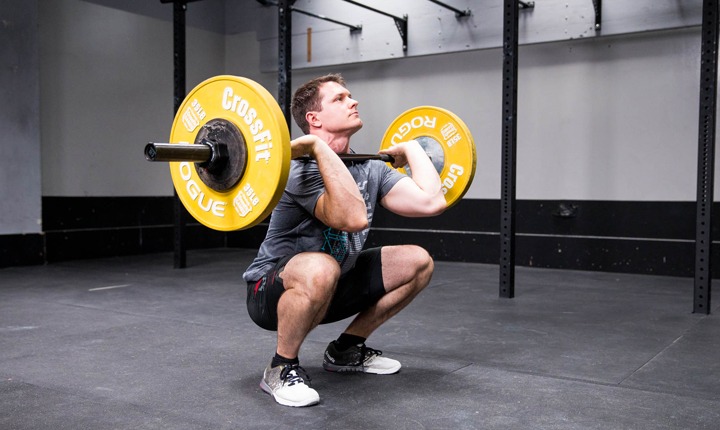
This workout helps you burn lots of fats and unwanted muscles of your body. This full-body dumbbell workout will help you balance your body and strengthening the core muscles.
Steps:
- Stand straight by holding dumbbells with your palms facing the shoulder height.
- Keep shoulder-width apart your toes pointing slightly outwards.
- Now start squatting down slowly and explode up thrusting the dumbbells above your head.
- Repeat these steps ten times or less than that.
- You can adjust weight as per your capacity.
3. Split Squat
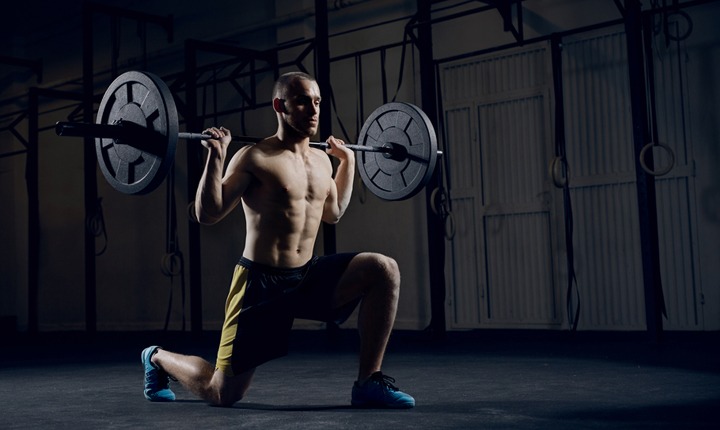
This is a multi-squat dumbbell workout that helps in conditioning your lower body, strengthen your bottom part and bringing balance in your legs.
Steps:
- Stand with the open space with your feet and shoulder-width apart.
- Tuck your elbows and place both of your hands on your hips if you are just practicing bodyweight split squats.
- You can also use dumbbells and hang them by your sides facing palms inwards.
- Now raise the heel of your back foot and see that your toes should touch the floor.
- Keep your back heels and hips straight.
- You can repeat the steps once more as per your limit.
Bottom Line
Hope these full-body dumbbell workouts will help you shape up your body, build muscles and strengthen both your muscles and joints. However, try to follow the steps and levels of exercises as per aforesaid guidelines to get a better result.


